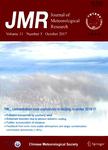版权所有:内蒙古大学图书馆 技术提供:维普资讯• 智图
内蒙古自治区呼和浩特市赛罕区大学西街235号 邮编: 010021

作者机构:Key Laboratory of Ecosystem Network Observation and ModelingInstitute of Geographic Sciences and Natural ResourcesChinese Academy of SciencesBeijing 100101 Key Laboratory of Watershed Geographic SciencesNanjing Institute of Geography and LimnologyChinese Academy of SciencesNanjing 210008
出 版 物:《Journal of Meteorological Research》 (气象学报(英文版))
年 卷 期:2020年第34卷第4期
页 面:786-797页
核心收录:
学科分类:083002[工学-环境工程] 0830[工学-环境科学与工程(可授工学、理学、农学学位)] 081802[工学-地球探测与信息技术] 07[理学] 08[工学] 0818[工学-地质资源与地质工程] 081602[工学-摄影测量与遥感] 0816[工学-测绘科学与技术] 0713[理学-生态学]
基 金:Supported by the National Key Research and Development Program of China(2016YFC0500203 and 2017YFC0503803) National Natural Science Foundation of China(31971507) Science and Technology Program of Qinghai Province(2018-ZJ-T09)
主 题:Three-River Source Region(TRSR) start of vegetation growing season(SOS) spatiotemporal change elevation climate change China
摘 要:How vegetation phenology responds to climate change is a key to the understanding of the mechanisms driving historic and future changes in regional terrestrial ecosystem productivity. Based on the 250-m and 8-day moderate resolution imaging spectroradiometer(MODIS) normalized difference vegetation index(NDVI) data for 2000-2014 in the Three-River Source Region(TRSR) of Qinghai Province, China, i.e., the hinterland of the Tibetan Plateau, we extracted relevant vegetation phenological information(e.g., start, end, and length of growing season) and analyzed the changes in the TRSR vegetation in response to climate change. The results reveal that, under the increasingly warm and humid climate, the start of vegetation growing season(SOS) advanced 1.03 day yr-1 while the end of vegetation growing season(EOS) exhibited no significant changes, which led to extended growing season length. It is found that the SOS was greatly affected by the preceding winter precipitation, with progressively enhanced precipitation facilitating an earlier SOS. Moreover, as the variations of SOS and its trend depended strongly on topography, we estimated the elevation break-points for SOS. The lower the elevations were, the earlier the SOS started. In the areas below 3095-m elevation, the SOS delay changed rapidly with increasing elevation;whereas above that, the SOS changes were relatively minor. The SOS trend had three elevation break-points at 2660, 3880, and 5240 m.